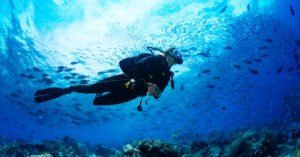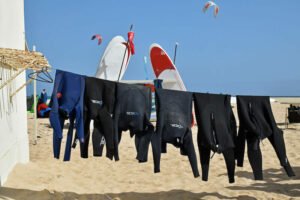Wetsuits are an essential piece of gear for many water-based activities, but they can be a significant investment, especially if you’re just getting started as a driver or surfer. So, how much does a wetsuit cost?
For a high-end wetsuit, prices are usually around $500 US dollars but can go as high as $1000 US dollars or more. When choosing a wetsuit, it is important to consider what activities you will be using it for and the climate. This pricing guide will look at the different types of wetsuits available and the various factors that affect cost. Additionally, we’ll explore the benefits of expensive wetsuits and suit rental.
Key Takeaways:
- Wetsuits can cost as little as $50 or as much as $1000
- The price depends on the brand, materials used, features included, size, and fit
- Wetsuits can be shorty, with sleeves cut before the elbow and above the knee.
- Materials vary from neoprene to spandex and even titanium.
- Features can include things like watertight zippers and reinforced knees and seat.
- Expensive wetsuits can be worth the price for experienced surfers or divers in specific conditions
- Wetsuit rental is a great way to start out before investing in an expensive suit
- Size and fit are important for both comfort and function.
What Factors Affect Wetsuit Costs?
Several factors affect how much a wetsuit costs. The most important factor is the intended use. Wetsuits are designed for different activities and climates, and this will have a big impact on the price. For example, a wetsuit meant for surfing in warm water will be very different from one made for diving in cold water.
The wetsuit price can be determined by a number of factors, including:
- The thickness of the wetsuit → wetsuit thickness guide
- The intended use → wetsuit temperature guide
- Flexibility → best kitesurfing wetsuits
- The materials used → how does a wetsuit work?
- The degree of waterproofness → wetsuit vs. drysuit
How Much Do Wetsuits Cost: Style
The style of wetsuit you choose will also affect the price. Style is mostly a matter of personal preference, but it can also be dictated by the activity you plan to use the suit for.
Whether you are looking for a wetsuit for triathlon or a scuba wetsuit does make a big difference.
The two main styles of wetsuits we want to focus on for now are:
- Springsuits – These are the shortest and most common type of wetsuit, with sleeves cut before the elbow and above the knee. They usually have short sleeves and come in a variety of colours and designs. Also known as a shorty, a Springsuit is typically made from neoprene and is meant for use in moderate to warm climates.
- Fullsuits – As the name suggests, these wetsuits cover the entire body. They have long sleeves and legs and are usually made from neoprene or spandex. Fullsuits are typically worn in colder climates or for more intense water sports.
You can also get partial wetsuits for just the top or just the bottom half of your body. The wetsuit style you choose will have a big impact on the price. Springsuits are the cheapest option, while fullsuits and drysuits can cost significantly more.
How Much Do Wetsuits Cost: Material
The material of the wetsuit also affects the price. Wetsuits are typically made from neoprene, spandex, or titanium. Neoprene is the most common and least expensive material, while titanium is the most expensive. Spandex is somewhere in the middle.
The first ever worn wetsuit was made of neoprene, and it still is the most famous wetsuit material. Wetsuits for swimming now might still look the same. But the science and years that went into developing it to differentiate between wetsuit sizes for women and men, but between the special needs of each and every type of sports, show in the price.
- Neoprene – Neoprene is a synthetic rubber that is resistant to water and provides good insulation. It is the most common material used in wetsuits and usually the least expensive.
- Spandex – Spandex is a synthetic fiber that is stretchy and lightweight. It is often used in diving wetsuits to provide good flexibility and range of motion.
- Lycra – Lycra is a synthetic fiber that is stretchy and lightweight. It is often used in surfing wetsuits as it provides good flexibility and range of motion.
- Titanium – Titanium is a metal that is resistant to water and provides excellent insulation. It is the most expensive material used in wetsuits, but it is also the most durable. Titanium is a strong and lightweight metal that is resistant to corrosion. It is often used in high-end wetsuits as it provides superior insulation, but this will increase the cost of your suit.
The material of the wetsuit will have a big impact on the price. Wetsuits made from neoprene are usually the cheapest, while those made from titanium can be quite expensive. Let’s look at the capabilities of a neoprene suit when it comes to water temperature:
| Neoprene Wetsuit (Thickness in Millimeters) | Water Temperature (Degrees Fahrenheit) |
| 1-1.5 | 75-85 |
| 2-3 | 70-80 |
| 4-5 | 60-70 |
| 6-7 | 50-60 |
How Much Do Wetsuits Cost: Thickness
Wetsuit thickness is measured in millimeters (mm), and the thicker the wetsuit, the more insulation it will provide. Wetsuits are typically 3mm to 5mm thick, but you can also find suits as thin as 1mm or as thick as 7mm. The thickness of the wetsuit is one of the most important factors in determining the price.
The thicker the wetsuit, the more it will cost. Wetsuits that are 3mm thick are typically the least expensive, while those that are 5mm or 7mm thick can be quite expensive.
Here is how the thickness and material of your suit relate directly to water temp and the activity you’re doing:
| Water Temperature | Wetsuit Thickness |
| Over 75°F | No suit/Bathing suit |
| 72°F – 75°F | 1mm or 2mm neoprene |
| 66°F – 72°F | 2mm shorty wetsuit |
| 62°F – 67°F | 2mm full suit |
| 55°F – 67°F | 2mm full suit or 3/2mm full suit |
| 50°F – 57°F | 4/3mm full suit, booties, gloves, and optional hood |
| 46°F – 53°F | 5/4mm full suit with hood, booties, and gloves |
| Under 46°F | 6/5mm or 6/4mm full suit with hood, booties, and gloves |
The material and thickness determine the flexibility of a wetsuit. Wetsuits made from neoprene are typically the most flexible, while those made from titanium are the least flexible. The thickness of the wetsuit also affects flexibility, with thicker wetsuits being less flexible than thinner ones.
Having a variety of options for what to wear under your wetsuit gives you flexibility, allowing you to choose one wetsuit thickness and easily adjust by adding layers underneath if needed.
How Much Do Wetsuits Cost: Quality
Some wetsuits are made quite cheaply with simple seams and stitching that is not very durable. Other wetsuits are made with high-quality materials and construction that will last for many years. The quality of the wetsuit is another important factor in determining the price.
Cheaper wetsuits are made with simple seams and stitching that are not very durable. These wetsuits will typically cost less than $100.
Mid-range wetsuits are made with better materials and construction than cheap ones, but they are not as high-quality as expensive ones. These wetsuits will typically cost between $100 and $300. These can fall apart after a few uses as you squeeze in and out of a wetsuit.
The most expensive wetsuits are made with the best materials and construction. Wetsuits made with high-quality materials and construction will last for many years. These wetsuits will typically cost more than $300. These wetsuits are made to be thrashed around in the surf and will still look good after years of use. Higher quality suits have double or even triple seams that are designed to last longer and last longer.
Wetsuits are available in a wide range of wetsuit sizes to fit everyone from very small children to large adults. The size of the wetsuit is another important factor in determining the price. Wetsuits that are made for larger people will typically cost more than those made for smaller people.
Reading Tip
Searching for the perfect wetsuit size? Our wetsuit size chart is here to help you find the ideal fit!
How Much Do Wetsuits Cost: Seals
Seals are an important part of a wetsuit as they help to keep water out and prevent heat loss. The type of seal used on a wetsuit will have a big impact on the price.
Most wetsuits have a simple seal around the neck, wrist, and ankle.
Ideally, this slows the flow of water going in and out of the suit. However, some wetsuits have specially made seals that greatly reduce the flow of water into a wetsuit. These seals are made of different materials that are very effective in keeping you warm longer in the water.
There are a few different common types of seals, including:
- Flatlock – The most common type of seal is a flatlock seam. This is the most basic and least expensive seam in the wetsuit industry. It’s usually found in 2mm and 2mm wetsuits and spring suits. These seals are quite cheap to produce and are typically found on cheaper wetsuits.
- GBS Glued and Blind Stitched Seal – A GBS seal is a step up from a flatlock seam as it’s glued and stitched. This means that the neoprene is first glued together and then stitched. This makes for a stronger seal that will last longer. These seals are found on wetsuits that are 3mm to 5mm thick.
- Fluid Sealed Seam – A fluid sealed seam is the strongest and most expensive type of seal. The neoprene is glued and stitched like a GBS seam, but it’s also sealed with a special liquid that makes it watertight. These seals are found on wetsuits that are 5mm or thicker.
- Taped Seal – A taped seal is similar to a fluid sealed seam, but it’s not as strong or expensive. The neoprene is glued and stitched like a GBS seam, but it’s then sealed with a special tape that makes it watertight. These seals are found on wetsuits that are 5mm or thicker.
How Much Does a Scuba Suit Cost: Extra Additions to Your Suit
Wetsuits have a simple design with the main purpose of keeping you warm in the water; however, you can add extras to a wetsuit to make your life easier.
Some convenient additions to your wetsuit include:
- Wetsuit Boots – Wetsuit boots are an extra layer of neoprene that goes over your feet and calves. They help to keep your feet warm in the water and make it easier to put on and take off your wetsuit. Wetsuit boots typically cost between $20 and $60.
- Wetsuit Gloves – Wetsuit gloves are an extra layer of neoprene that goes over your hands and wrists. They help to keep your hands warm in the water and make it easier to put on and take off your wetsuit. Wetsuit gloves typically cost between $20 and $60.
- Wetsuit Hood – A wetsuit hood is an extra layer of neoprene that goes over your head and face. They help to keep your head and face warm in the water and make it easier to put on and take off your wetsuit. Wetsuit hoods typically cost between $20 and $60. Some wetsuits even have a built-in hood.
- Added Features – You can have hooks built into a suit to attach items to it, such as a knife, flashlight, or camera. You can also get wetsuits with different types of closures, such as a zipper or velcro. These added features will increase the price of the wetsuit.
Shorty Springsuits vs. Fullsuits: A Price Breakdown
When it comes to cost, there are two types of wetsuits on the market: shorty springsuits and fullsuits. Shorty springsuits are less expensive than fullsuits because they don’t cover your entire body. Fullsuits are more expensive because they provide more coverage and warmth.
Shorty-Springsuits
A shorty springsuit is a type of wetsuit that only covers your torso and legs. They typically have long sleeves and come in a variety of colors and patterns. Shorty springsuits are less expensive than fullsuits because they don’t cover your entire body.
With springsuits, you can expect:
- Usually trade-offs in material quality and thickness.
- The more money you spend, the higher quality neoprene you can get.
- They are good for warm water conditions or as a layering piece.
- They typically cost between $75 and $200.
Fullsuits
A fullsuit is a type of wetsuit that covers your entire body. They typically have long sleeves and come in a variety of colors and patterns. Fullsuits are more expensive than shorty springsuits because they provide more coverage and warmth.
With fullsuits you can expect:
- Higher quality neoprene that is thicker and warmer.
- The thicker the suit, the more expensive it will be. If you plan to use the suit in relatively warm waters, the thickness is not so important.
- However, if you plan to spend time in cold water, it’s a good idea to invest in a thicker suit.
- They typically cost between $200 and $500.
Another significant difference between low-end and high-end complete suits is the insulation. More expensive than a shorty, but worth the investment if you plan on spending a lot of time in the water.
Are Expensive Wetsuits Worth It?
Expensive wetsuits are typically made with higher-quality materials that will last longer. They also usually have added features, such as a built-in hood or different types of closures.
An entry-level system with superior design, quality, flexibility, durability, and neoprene will always make a wetsuit more expensive. High-end neoprene will always cost more. New technologies and features, such as integrated gloves and boots, also add to the price tag.
When it comes to wetsuits, you really do get what you pay for. The more expensive wetsuits will last longer, be made with higher-quality materials, and have more features. If you’re just starting out, you may want to consider a less expensive wetsuit to see if you even like the sport before investing a lot of money.
Reading Tip
Expensive wetsuits are worth it if you’re looking for a wetsuit that will last a long time and provide you with all the features you need. For example, our wetsuits are doubled stitched and glued on the seams, to be as durable as possible.
When Should I Buy a Wetsuit?
Buying a wetsuit is a personal decision that depends on many factors, such as water temperature, budget, and planned usage.
If you live in a cold-water climate, you’ll need a thicker wetsuit to keep you warm. If you live in a warm water climate, you can get away with a thinner wetsuit.
The type of wetsuit you buy will also depend on the type of surfing you’re doing. If you’re going to be doing a lot of SUPing, you’ll need a different type of wetsuit than if you’re going to be surfing on a shortboard.
Reading Tip
Wetsuits are available all year round, but the best time to buy one is during the off-season. This is because retailers offer discounts on last season’s models to make room for the new season’s stock. You can find some great deals if you’re willing to do a little research.
Wetsuits come in a wide range of prices, depending on the style, brand, and features. You can find a basic wetsuit for as little as $50-$75, or you can spend over $500 for a top-of-the-line wetsuit. It’s important to choose the right wetsuit for your needs, so be sure to do your research before making a purchase.
How Much Does It Cost to Rent a Wetsuit?
Wetsuit rental is available on a daily or weekly basis, depending on your requirements. You can even find wetsuit rental packages that include other surfing gear, such as a surfboard and rash guard. If you’re planning on renting a wetsuit, be sure to call ahead to reserve one. Wetsuit availability can be limited.
Many online sites, such as Wetsuit Rental, offer them for rent and all the associated information on the cost of them. However, you need to make sure you return it in the same condition you took it or be prepared to pay a large amount in compensation.
Reading Tip
The rental cost depends on the quality of the wetsuit and how long you want to keep it. If you like to rent a wetsuit, it will cost you between $15 and $50 for a day and $175 to $200 or even more for the whole week.
Conclusion: How Much Do Wetsuits Cost?
Investing in a wetsuit doesn’t have to break the bank, but finding the right balance between quality and budget is key. Whether you’re buying a basic wetsuit for casual dips or a high-performance scuba suit for deep dives, there’s a price point for every adventurer. And once you’ve chosen the perfect one, don’t forget to learn how to wash a wetsuit properly to keep it in top condition. Still curious about prices? Dive deeper into specifics like how much does scuba diving cost to ensure you’re fully prepared for your underwater adventures. Happy splashing!
FAQ – Most asked questions
A scuba suit typically costs between $100 and $500, depending on the brand, thickness, and materials. High-end drysuits designed for colder water or advanced diving can go upwards of $1,000 or more.
Wetsuits generally range from $50 to $500, with prices varying based on thickness, style, and features. Entry-level wetsuits are more affordable, while specialized wetsuits for colder conditions or performance can be pricier.
A good-quality wetsuit usually costs around $200 to $400, offering the perfect balance between durability, comfort, and performance. Higher-end options may cost more, but they provide better insulation and flexibility.
Yes, wetsuits are widely available for rent at most dive shops or water sports centers. Rental prices typically range from $10 to $30 per day, making it a convenient option for occasional users.









